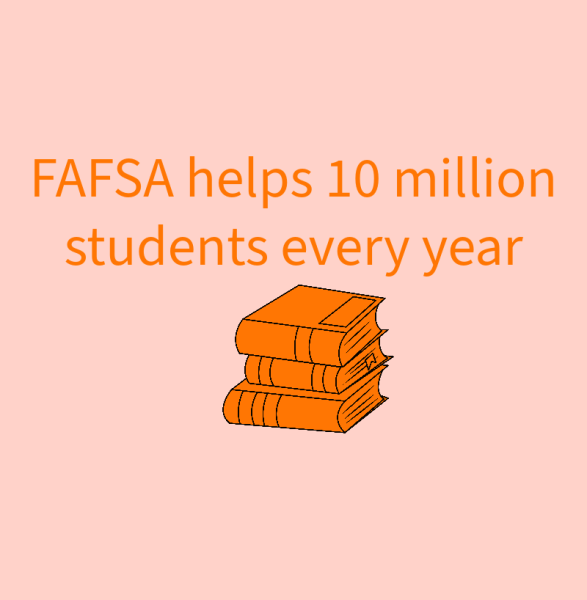Understanding the effects of poverty
Vincent Niewald News Editor
April 25, 2023
The Oxford English dictionary defines poverty as “the state of being extremely poor.” In the U.S., poverty means living on less than $36 per day. The U.S. Census Bureau sets this standard, and it is called the Poverty Threshold. Poverty is arguably one of the most difficult and frustrating things for a student to have to deal with.
For some, it means not being able to participate in field trips or extracurricular activities. For others, it could mean having to get a job to support their families while still going to school full time. An anonymous student interviewed said that being in poverty can be frustrating, and even embarrassing.
“I never really thought about it. I mean, I knew my family wasn’t rich or anything, but I didn’t really know that we were poor, I guess. I just assumed that we were normal. Having to eat the same things most nights for dinner, or my parents always being busy with work or whatever, I just assumed that was normal. I thought that was what happened with everyone. I didn’t get it when one time a friend I had had said her mom stayed home while her dad worked. I guess that was when I started thinking maybe we weren’t normal,” the student said.
According to documentation from Assistant Principal Nathan Bacon, there are explicit definitions and levels of need established for students who are eligible to receive free and reduced priced lunches at East.
“Children from households with incomes at or below 130 percent of the Federal poverty level are eligible for free meals. Children who are homeless, runaway, or migrant; foster child; enrolled in a Federally-funded Head Start Program or a comparable State funded Head Start Program or pre-kindergarten programs or in an Even Start Program are categorically eligible for free school meals,” the Nebraska Student and Staff Record System (NSSRS), Child Nutrition Program, said.
Primarily, the program serves as way to lift some weight off of the shoulders of students and parents. It gives those students who need it food security, at least during the school year.
Free and reduced priced lunches help students not have to worry about where their next meal will come from. Eligible students also receive discounts on various other programs throughout East, which they may not have been able to utilize otherwise.
“A child eligible for a reduced price meal is based on family size and income. Children identified through Direct Certification are eligible for reduced meal benefits because they, or any household members, receive benefits under Medicaid by income eligibility. Children from households with incomes at 131 percent, but no greater than 185 percent, of the Federal poverty level are eligible for reduced price meals,” NSSRS Child Nutrition Program said.
It can be difficult for those who have never experienced poverty to understand what it is like. It’s easy for people to look from the outside and talk about how simple it is to escape poverty, or about how a student can just “find time” for homework, but most times, it isn’t anywhere near that easy. To help further teachers’ understanding of the impacts of poverty, East social worker Susan Jones helped run a poverty simulation of sorts for faculty, so that staff could get a deeper understanding of what some students’ daily lives are like.
“Basically, it takes you through a month in poverty. So each week is 17 minutes, and you’re assigned a family and you have a role. You might be a 65-year-old, single parent taking care of a grandparent. You don’t have a job, you just lost your social security. So you have to play that role of ‘Where would I go?’ And then we had community resources set up,” Jones said.
The simulation emulated what life is like to a deep extent. There were “transportation tickets” to represent a car or public transit, and each family was only given a certain amount per week. “Food tickets” represented food, and were necessary for keeping a family alive as well. There were even various services, all in an attempt to make the simulation as realistic as possible.
“So we had a homeless shelter, we had employment, we had the school, we had caseworkers, the bank, a pawnshop, things like that. So you had to kind of figure out ‘how am I going to survive within this role.?’ It gave people a chance to live in poverty, if they maybe haven’t experienced that before, and the stress of it. You couldn’t go anywhere without a transportation ticket. If you didn’t have that, how are you going to get it? People got robbed, we had the police, who were our SROs, who were available,” Jones said.
The simulation showed how frustrating life can be for people in poverty. There are so many things to keep track of that most people don’t even worry about. Unfortunately, this is the reality for many people in the U.S., and even many here in Bellevue. Often, families feel like sacrifices need to be made, and every choice has a consequence.
“We had some people that were stealing from other people and they would get robbed if you hadn’t paid. If you hadn’t gone to the grocery store to buy your groceries then we kept a list of that and we’re like, ‘Oh, you haven’t fed your family in two weeks,’ then CPS gets called and then they have to go answer it. Or ‘you didn’t pay your mortgage,’ and that was a priority. So then the third week of that they might have been evicted,” Jones said.
The point of the simulation was to engage faculty while teaching them about poverty. It showed how difficult life could be, and how important it is to be understanding of students because it is impossible to see just what a student is going through. It is often better when teaching people to try to immerse them within the subject.
“Instead of listening to a lecture about poverty and data, it was a real thing to simulate what it might be like, so that they could have a better understanding. Even though it’s, again, only two and a half hours, but for some families it’s that every day. So hopefully it gives some insight to teachers and our staff,” Jones said.






